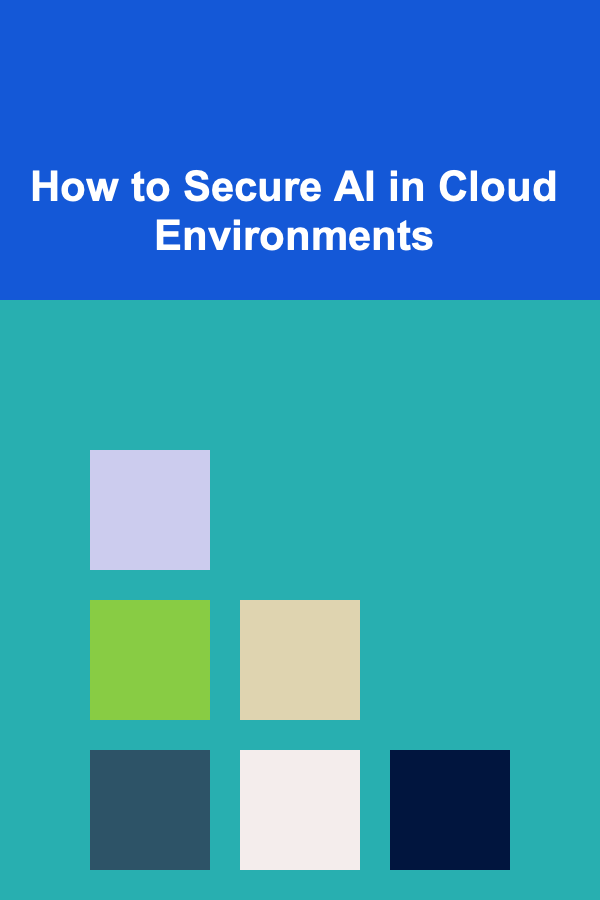
How to Secure AI in Cloud Environments
ebook include PDF & Audio bundle (Micro Guide)
$12.99$8.99
Limited Time Offer! Order within the next:

Artificial Intelligence (AI) has revolutionized industries by enabling faster, smarter decision-making, automation, and complex problem-solving capabilities. As AI technologies mature, cloud computing platforms have emerged as the primary environment for developing, testing, and deploying AI models. The scalability, flexibility, and cost-effectiveness of cloud environments make them ideal for hosting AI systems, but this shift also introduces a new set of security challenges. AI systems running in the cloud are susceptible to a variety of risks, ranging from data breaches to model manipulation.
In this article, we will delve into the complexities of securing AI in cloud environments, exploring the various threats, risk mitigation strategies, and best practices. We will examine both technical and organizational approaches to ensure the protection of AI assets, models, and data.
Understanding the Cloud Environment and AI Security
Cloud computing provides an on-demand, scalable infrastructure for hosting applications, data, and services. For AI, cloud platforms offer powerful compute resources like Graphics Processing Units (GPUs) and Tensor Processing Units (TPUs), which are essential for training deep learning models. Major cloud providers, including Amazon Web Services (AWS), Google Cloud, and Microsoft Azure, offer specialized AI services that streamline the development and deployment of machine learning models.
However, the flexibility and openness of cloud environments come with significant security concerns:
- Data Security: In cloud environments, data is often stored and processed remotely, which raises concerns about data confidentiality, integrity, and availability. AI models require access to vast amounts of data to learn and improve. This data, whether sensitive or non-sensitive, is vulnerable to leaks, breaches, or unauthorized access.
- Model Integrity: AI models themselves can become targets for malicious actors. Adversarial attacks, model poisoning, and other forms of manipulation can corrupt the AI's performance, leading to incorrect outputs, decision-making errors, and security vulnerabilities.
- Access Control: Cloud environments often provide multiple access points for developers, engineers, and data scientists. Managing who can access what part of the infrastructure is vital to prevent unauthorized personnel from manipulating AI models or gaining access to sensitive data.
- Compliance and Regulatory Issues: Data stored in the cloud might span multiple jurisdictions with different data protection laws (e.g., GDPR in Europe, CCPA in California). Ensuring compliance with these laws and regulations is crucial, as violations can lead to legal liabilities and reputational damage.
- Network Security: Cloud environments rely heavily on internet connectivity, which exposes AI models and data to network-based attacks, such as Distributed Denial of Service (DDoS) attacks or man-in-the-middle (MITM) attacks. Ensuring secure communication between AI components in the cloud is a key challenge.
Given these risks, a multi-layered security strategy is necessary to safeguard AI systems in cloud environments. Below, we outline the strategies and best practices for securing AI in the cloud.
Key Strategies for Securing AI in Cloud Environments
1. Data Protection and Encryption
Data is the lifeblood of AI systems, and protecting it is of paramount importance. In cloud environments, AI systems often deal with massive datasets, some of which may contain personal, financial, or proprietary information. Unauthorized access or exposure of this data can lead to privacy violations, financial losses, and brand damage.
Encryption
- At Rest: Ensure that data stored in cloud storage systems is encrypted. Use industry-standard encryption protocols such as AES-256 to protect data at rest. Cloud providers typically offer built-in encryption mechanisms, but it's crucial to verify that they are enabled and properly configured.
- In Transit: Encrypt data during transmission between cloud services and end-users. SSL/TLS (Secure Socket Layer/Transport Layer Security) is essential for securing the communication channels.
- End-to-End Encryption: For sensitive AI applications, implement end-to-end encryption, ensuring that only authorized entities can decrypt and access the data.
Data Masking and Anonymization
Data masking techniques can obfuscate sensitive information, ensuring that even if a breach occurs, the data remains unusable. Anonymization can also be used for training AI models on sensitive data without exposing personal details.
2. Identity and Access Management (IAM)
Managing user identities and access rights is critical in preventing unauthorized access to AI models and data in the cloud. Implementing robust Identity and Access Management (IAM) policies can reduce the risk of insider threats and ensure that only authorized personnel have access to sensitive assets.
Role-Based Access Control (RBAC)
- Granular Permissions: Use RBAC to restrict access based on job roles. For instance, data scientists might need access to training datasets, but not to production environments where the model runs.
- Least Privilege Principle: Always grant the minimum level of access necessary for a user or application to perform their tasks. This minimizes the damage in case of a compromised account.
Multi-Factor Authentication (MFA)
Implement MFA to enhance the security of access credentials. Even if a password is compromised, MFA adds an additional layer of protection by requiring a second factor of authentication (e.g., a one-time password or biometric data).
Audit Logging
Enable detailed logging to track who accesses what data and models, when, and why. Audit trails provide a crucial layer of accountability and help identify suspicious activities or potential breaches.
3. Securing AI Models
The AI models themselves can be targeted in several ways, including adversarial attacks, model stealing, and poisoning. Securing these models is essential to ensure that the outputs remain reliable, accurate, and secure.
Adversarial Machine Learning Defense
Adversarial attacks involve crafting input data specifically designed to fool AI models into making incorrect predictions. There are several ways to defend against adversarial attacks:
- Adversarial Training: Introduce adversarial examples during the training process to help the AI model recognize and resist malicious inputs.
- Robust Models: Use model architectures designed to be more resistant to adversarial inputs, such as robust neural networks.
- Input Sanitization: Preprocess input data to detect and filter out potential adversarial examples before they reach the model.
Model Watermarking and Fingerprinting
To prevent model theft and unauthorized use, consider watermarking your AI models. This involves embedding a unique signature or fingerprint within the model that can later be used to verify ownership. If the model is copied or reused without permission, the watermark can serve as evidence of intellectual property theft.
Model Poisoning Prevention
Model poisoning attacks involve injecting harmful data into the training set to manipulate the AI model's behavior. To defend against model poisoning:
- Data Validation: Use data validation techniques to ensure that the training data is clean and free from malicious injections.
- Secure Data Provenance: Track the origin of training data to ensure its integrity and authenticity.
4. Secure Communication and Network Security
AI systems in the cloud often rely on distributed architectures, where different components of the AI pipeline (e.g., data storage, training, and inference) communicate with each other over the internet. This introduces several network security challenges.
Encryption of Communications
As mentioned, all communication channels between AI systems should be encrypted to prevent MITM (man-in-the-middle) attacks, where attackers intercept and manipulate data transmitted between systems. Use protocols like TLS and VPNs to secure the communication paths.
Virtual Private Networks (VPNs)
If possible, deploy AI systems within a private cloud or virtual private network (VPN) to limit exposure to the public internet. A VPN can help protect data from eavesdropping and unauthorized access.
DDoS Protection
Distributed Denial of Service (DDoS) attacks are a common form of cyberattack that targets the availability of cloud-based services. Use DDoS protection services offered by cloud providers to detect and mitigate large-scale attacks before they disrupt the AI infrastructure.
5. Continuous Monitoring and Threat Detection
The dynamic nature of AI in cloud environments requires constant vigilance. Threats evolve, and adversaries adapt their tactics, so it is essential to employ continuous monitoring to detect potential security incidents early.
AI-Powered Threat Detection
Use AI-powered security tools to monitor and analyze network traffic, system behavior, and access logs. These tools can identify anomalies that might indicate an ongoing attack or a breach.
Intrusion Detection Systems (IDS)
Deploy IDS solutions that can detect unauthorized access attempts, malware infections, or unusual activity within your cloud infrastructure. These systems should be fine-tuned to the specific environment and the AI workloads it hosts.
6. Compliance and Legal Considerations
In addition to technical security measures, organizations need to ensure that their AI deployments comply with relevant data protection laws and industry regulations.
GDPR and Data Sovereignty
When working with AI in the cloud, especially if dealing with European or international clients, ensure compliance with GDPR (General Data Protection Regulation). AI systems must adhere to data protection rules, including the right to be forgotten, data portability, and processing transparency.
Cloud Provider Certifications
Verify that your cloud service provider has the necessary certifications, such as ISO 27001, SOC 2, and others, which demonstrate compliance with established security and privacy standards.
Conclusion
Securing AI in cloud environments is not just about applying a few technical fixes but requires a comprehensive, multi-layered strategy that spans data protection, model security, network defense, and compliance. With the rapid adoption of AI and cloud technologies, organizations must take proactive measures to secure these critical systems against evolving threats.
By adopting best practices such as encryption, robust access controls, adversarial defense mechanisms, continuous monitoring, and compliance with legal frameworks, organizations can significantly mitigate the risks associated with hosting AI systems in the cloud. As AI continues to shape the future of business, securing these systems will be essential to ensure their reliability, safety, and ethical use.
Reading More From Our Other Websites
- [Home Maintenance 101] How to Care for Your Induction Cooktop
- [Small Business 101] Best Approaches to Conducting a SWOT Analysis with Limited Resources in a Startup
- [Personal Care Tips 101] How to Achieve a Smooth Foundation Application
- [Personal Care Tips 101] How to Create a Relaxing Bath Routine with Body Wash
- [Home Budget Decorating 101] How to DIY a Stunning Accent Wall with Affordable Materials
- [Tiny Home Living Tip 101] Best Ways to Optimize Closet Space in a 100‑Sq‑Ft Living Area
- [Organization Tip 101] How to Optimize Your Closet Layout for Better Flow
- [Weaving Tip 101] From Thread to Story: Mastering the Art of Tapestry Weaving
- [Personal Finance Management 101] How to Navigate Health Insurance Options: A Beginner's Guide to Coverage and Costs
- [Toy Making Tip 101] From Cardboard to Castles: Easy Homemade Toy Projects for Kids

Exploring Public Transportation Alternatives for a Greener Commute
Read More
How to Create a Family Command Center in Your Home
Read More
How to Organize Your Home Maintenance Tasks for Maximum Efficiency
Read More
How to Set Up a Functional Laundry Room for Ease
Read More
Researching Trending Designs for Print-on-Demand: A Deep Dive
Read More
Developing a Killer Niche Marketing Strategy
Read MoreOther Products

Exploring Public Transportation Alternatives for a Greener Commute
Read More
How to Create a Family Command Center in Your Home
Read More
How to Organize Your Home Maintenance Tasks for Maximum Efficiency
Read More
How to Set Up a Functional Laundry Room for Ease
Read More
Researching Trending Designs for Print-on-Demand: A Deep Dive
Read More